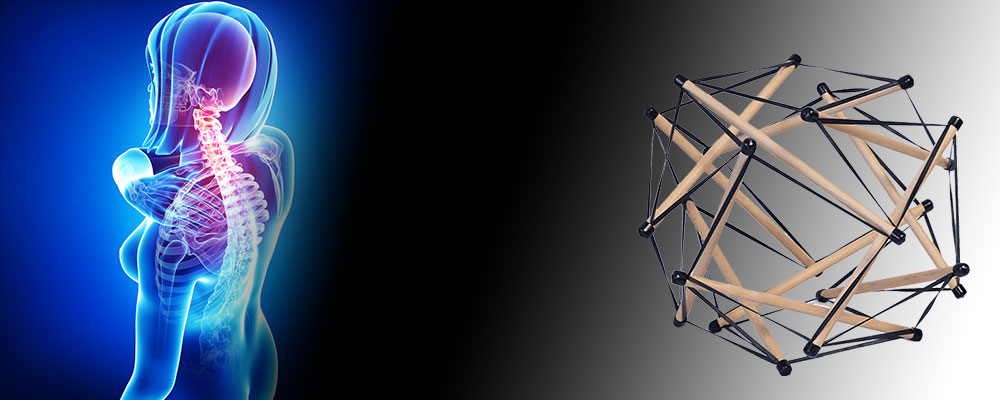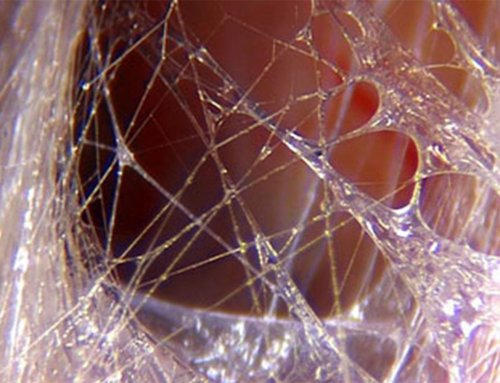
Joint instability may well be one of the most misunderstood concept in the field of human biomechanics. It turns out the body doesn’t work on Newtonic principles like a building because buildings don’t move. The body floats in space and the new model of stability is called “tensegrity”.
The old model of stability
When we think about the concept of stability we have a tendency to think of it as continuous compression structures. We think that the human body works like a building. A large number of bricks that sit on top of each other with a very strong foundation at the bottom to take all the compression forces from above. So, we think that the head sits on top of the neck, the neck sits on top of the spine, the spine sits on top of the hips, etc. and the skeleton that we see in all anatomy classes reinforce the idea that we are a stack of bricks.
We think about muscles like they are individual units that like the cables on a crane move the skeleton system around and perform certain tasks. It is a very robotic and industrialized way of thinking about the body. It is certainly not completely useless, however it is incomplete. The body isn’t built on leverage and Newtonic mechanics but on a different mechanics. The body does not work like a building because a building doesn’t move. The human body is a living thing, it is constantly moving and its stability is provided by the perfect balance between tension and compression.

Our body’s integrity depends on the tension of our soft tissues around the bones and not the other way around. The skeleton doesn’t hold the muscles and the fascia up in the air. The bones are being held together by the tension in the fascia. Another misunderstood idea is that the skeleton is one unit when in fact it is a series of individual bones that are floating inside the fascia tissue. This is the concept of tensegrity – the new model for human biomechanics.
The new model of stability
Tensegrity, tensional integrity, or floating compression is a structural principle based on a system of isolated components under compression inside a network of continuous tension and arranged in such a way that the compressed members (usually bars or struts) do not touch each other while the prestressed tensioned members (usually cables or tendons) delineate the system spatially.

Tensegrity structures are based on the combination of a few simple design patterns:
- members loaded in either pure compression or pure tension. This means that the structure will only fail if the cables yield or the rods buckle. This enables the material properties and cross-sectional geometry of each member to be optimized to the particular load it carries.
- preload or tensional prestress allows cables to always be in tension, to maintain structural integrity.
- mechanical stability, which allows the members to remain in tension/compression as stress on the structure increases. The structure also becomes stiffer as cable tension increases.
Biological structures such as muscles, bones, fascia, ligaments, and tendons, or rigid and elastic cell membranes, are made strong by the unison of tensioned and compressed parts. The musculoskeletal system maintains tension in a continuous network of muscles and connective tissues, while the bones provide discontinuous compressive support. Even the human spine, which seems at first glance like a stack of vertebrae resting on each other, is actually a tensegrity structure because the individual vertebrae are floating in the fascia system.
Ligaments, tendons and the fascial system
When talking about ligaments or tendons specialists usually think of individual soft tissue structures that connect bone to bone or muscle to bone. While that certainly is the case, it is an image that is incomplete. T. Myers ran numerous studies with specialists that showed that there are no individual tendons or ligaments.
It turns out all ligaments are part of a larger fascia strain that usually connects multiple bones and muscles at the same time. One fascia strain can start at the feet and connect at your neck. This finally explains why sometimes where we feel the pain isn’t necessarily the cause. The body is connected and through this intelligent fascia system, your neck is literally connected to your feet. That is why we can’t look locally for solutions. The pain in the neck might actually be coming from your feet.
Having said that, our picture of human biomechanics and joint stability has been incorrect for a very long time. Specialists never included the role of the fascia in all this. Once you understand the body as a fascia system you understand that whatever happens locally at the level of an individual joint has consequences in the entire body. So, stability is then the consequence of the entire system working together.

What is instability?
According to UPMC, instability happens when tissues such as muscles, ligaments, and bones weaken. Once they have become weak, they no longer hold the bones of the joint in the proper place. Therefore joint misalignments can happen. Joints are supposed to be mobile but too much range of motion within a joint isn’t good either and when there is an excessive range of motion in a joint we call it instability. Traditionally, it is believed that stability is active and passive. Active stability is provided by the muscles and static stability by the ligaments. While all this is definitely true, muscles and ligaments aren’t the only ones responsible for stability. The stability of the body is provided by the strains of fascia that attach to bones, muscles, ligaments, and other structures. All these structures work together as a system and provide global stability to the body.
Full body instability and the fascia
Instability can happen to any joint in the body, from head to spine, knees, hips, shoulder, and ankle. It can happen due to an accident, improper repetitive movements, or too much inactivity which leads to weakness of the muscles. However, I have seen this happening more and more lately and that is full-body instability. This happens when the body has become so weak that it becomes incapable to carry its own weight anymore. Sufferers may present with head instability, spine instability, TMJ dysfunction, hip and knee instability, and ankle instability. All of these things can lead to a myriad of symptoms from chronic fatigue to extreme muscle weakness and chronic inflammation. This condition is often associated with lots of neurologic symptoms too. Most doctors still do not know how to diagnose it. For this reason, a long time may pass by until people receive the right diagnosis.
Full body instability is caused by a fascia system that has become completely compromised. It takes a long time to fix and my guess is that it will continue to grow in the next years. We have created a world in which never before were people required to move so little. It will soon start to show in the levels of instability that people experience.

Instability is deeply misunderstood
Here is how stability works. The strength of the muscles is definitely important when performing certain tasks. When lifting, carrying, and holding things the stability of your body is also provided by the fascia system. If muscle strength and intact ligaments were the only factors in providing joint stability athletes should be the most stable people in the world. However, that isn’t the case and we often see athletes dealing with some of the worst stability-related injuries. The reason is that stability isn’t provided just by the muscles or by ligaments but by the entire fascia system.
I injured my back almost 10 years ago and the reason why I know all these things is because I was one of the desperate people who looked for answers all over the world and no one was able to help me. I am an ex-professional athlete and I have basically torn my spine ligaments during a heavy deadlift. This event left my Sacroiliac Joint completely unstable. Every doctor that I went to offered me spinal fusion as the only solution saying that the stability of my sacroiliac joint was compromised because the ligaments were torn. Because I wanted to be able to continue to do sports I declined the surgery. After this, I spent 5 years of my life studying the body and how it works. My goal was to understand how to fix my body without putting screws into my spine.
My journey helped me understand instability
I underwent lots of very painful therapies to try to get the ligaments to be stable again. Needless to say, all these things only damaged me further instead of helping me. It wasn’t until I started to research the true elements of joint stability that I came across the concept of fascia and the tensegrity model. This has been a game-changer ever since. Once I understood this model I was able to recover. My back is now completely stable despite my ligaments being still loose. What people call “ligaments” is actually just a small part of a continuous strain of fascia. Ligaments are fascia. Tendons are fascia. And muscles are enveloped in fascia too.
My injury resulted in 9 other dislocated vertebrae and lots of other stability problems because I basically walked around with a dislocated sacrum for almost 5 years before I could fix it. Now I understand that stability isn’t provided by ligaments that attach to bones or by muscle strength but by the perfect balance between tension and compression forces in the body.
Compression is provided by the bones that push out and the tension is provided by the entire fascia system working together like one unit. This unit pushes into the compressive structures to provide stability. It’s this perfect balance between tension and compression, between yin and yang that gives the body its stability.



